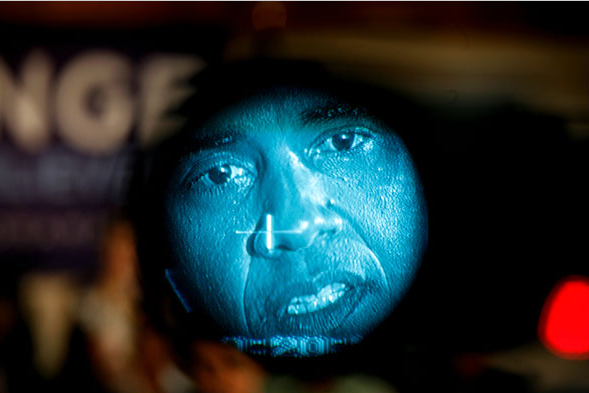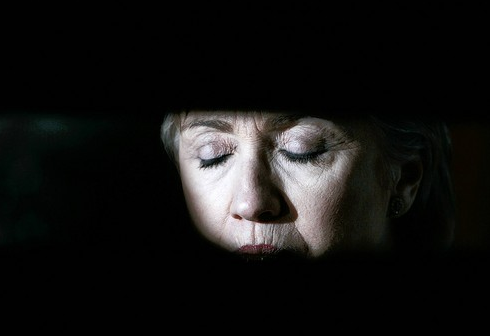Everybody knows that politicians are two-faced. They say one thing and mean another, or promise something to one audience and promise the opposite to someone else. They smile and smile and smile and we know that nobody can feel that happy. We know that they are supposed to put up a good front but have to be someone else inside, and so we don’t trust them. And then we go and vote according to how we like them or how we judge their “character.”
So it is that the politician’s face deserves some attention. And gets it. The photograph below is one of several that have featured the candidates up close and personal. Too close, perhaps:
You are looking at Barack Obama through a television camera viewfinder. Surely this is one example of the lengths to which photojournalists will go to create a distinctive image that might be picked out of the thousands sent to photo editors each day. This is distinctive and more. Some might say it’s a hatchet job–cutting Obama’s head away to make him look grotesque. Could be, but it also captures some of the elements of the presidential campaign as it is almost completely embedded in and defined by the media.
We could caption the photo “Moon Man.” The visual allusion is at once to the man in the moon and to an astronaut (think of the film 2001: A Space Odyssey). In either case he is far away, distant, almost alien. He also appears to be behind heavy glass, as if on the other side of an air lock. In fact he looks trapped in there, encased in the media apparatus of the campaign, ready for launch but also in danger of running out of oxygen.
The more you look, the worse it gets. The dark framing on the bushy brows, direct gaze, and exposed teeth might appear menacing to some, but look closer. I see someone assuming the look not of a predator, but of someone’s prey. The cross-hairs are just about dead center while he seems immobilized, caught in the hunter’s scope, stunned by the glare of a sudden flash, almost imploring us to help him. All we can do is stare and in staring note the moles, the pores, the creased skin–all evidence that here, in this twice mediated, highly distorted image, here we are actually seeing a real face.
But not the only one:
Again, it may have been taken for its novelty value, but it succeeds as a work of art. I won’t say this is Everywoman, but she is one very tired woman. She also is someone whose long experience with fatigue is matched by deep reserves of strength. Most of the American public have not a clue about how grueling the presidential campaign is, but you get a glimpse of it here.
I’m not backing Hillary in the campaign for the nomination, but I’m touched by this photograph. Perhaps it’s the contrast with the conventional shots of candidates smiling (much less the manic, bug-eyed shots the press likes to serve up about Hillary). Likewise, the closed eyes offer her to the viewer, as opposed to the demand placed by eye contact and the campaign generally. That’s only part of it, however. As with Obama’s image above, the dark framing isolates the face and all it stands for. But where Obama looks trapped, she has been exposed. We see her make-up and a tracery of wrinkles in spite of that. This, too, is an image of vulnerability. And look closer: it could be a death mask.
It certainly is a mask–and this is the photographer’s achievement. We are shown the candidate in an unguarded moment, one in which she is doing nothing to please anyone, and, sure enough, she is wearing a mask: the make-up, the disciplined concentration, the facial mask itself. And it is for precisely that reason that we can be sure we are seeing a real person.
Photographs by Damon Winter/New York Times; Carolyn Kaster/Associated Press.


This is very good: the mask showing us that this is a real person. Worth rolling around the mind for a while.
[…] 2001, according to the US National Climatic Data Center in Asheville, …news.nationalgeographic.comThe Political Mask Everybody knows that politicians are two-faced. They say one thing and mean another, or promise […]
My first thought, looking at the Obama photo, was not a camera lens but a telescopic sight, which considering the questions of race that have been raised lately, is disquieting.
[…] The Political Mask […]